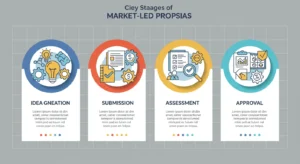Market Led Proposals Guide: Process, Examples & How to Apply
In today’s competitive and innovation-driven environment, market led proposals are changing how governments and private sectors collaborate. These proposals allow private organizations to bring forward new project ideas that address public needs before any official tender is released. Instead of waiting for the government to announce an opportunity, the market takes the initiative. This approach has proven to be an effective way to unlock creativity, drive efficiency, and deliver better public outcomes.
What Are Market Led Proposals and Why Are They Important
These are business ideas proposed by private entities to a government agency to solve a public problem or deliver an infrastructure or service need. The distinguishing feature of this process is that it originates from the private sector rather than the government. Unlike traditional procurement methods, where the public sector defines the project scope and invites bids, here the market presents innovative solutions that align with government priorities.
The importance of these proposals lies in the balance they create between innovation and public benefit. Governments gain access to expertise, efficiency, and financing from the private sector, while private companies benefit from exclusive opportunities to deliver major projects. In essence, market led proposals create a partnership model that accelerates development, reduces costs, and improves public services through collaboration and innovation.
Why Governments Adopt Market Led Proposals
Governments adopt them to attract private investment and stimulate economic growth. They recognize that businesses often have the agility and technical knowledge to identify solutions faster than the public sector. By opening the door for private sector ideas, governments can access fresh perspectives and unlock opportunities that may not emerge through standard procurement channels.
Another reason behind this approach is the efficient use of public resources. Since proponents bring their own funding, the government can pursue important projects without overburdening the budget. Moreover, such proposals encourage innovation, streamline decision-making, and promote partnership between sectors. Jurisdictions like Victoria, Western Australia, and New Zealand have already integrated structured frameworks for handling market-led proposals, ensuring transparency and fairness throughout the process.
Where Market Led Proposals Are Commonly Used
They are widely used in sectors that require large-scale investment and complex planning. In transportation and infrastructure, for example, private companies have introduced highway expansions, tunnel developments, and smart public transport systems through this model. In the energy and utilities sector, private investors propose renewable energy initiatives and modern grid systems that enhance sustainability.
Urban development projects, such as mixed-use communities, housing initiatives, and smart city designs, also benefit from this approach. The technology sector is another growing area, where digital systems, data management platforms, and AI-powered solutions are proposed to improve public services.
The Market Led Proposal Process and Stages
This process typically includes five structured stages. Understanding each step helps you prepare a strong submission.
Stage 0: Pre-Submission
This is the research and planning stage where proponents identify opportunities, assess public benefit, and ensure the idea does not duplicate existing projects. Early engagement with government agencies is crucial.

Stage 1: Initial Submission
The proponent submits a high-level concept paper explaining the project idea, objectives, estimated cost, and how it benefits the public. The government reviews it to determine eligibility for further consideration.
Stage 2: Detailed Proposal
If accepted, the proponent develops a full business case, including feasibility studies, technical assessments, and risk management strategies. This stage is about proving the project’s viability and alignment with public priorities.
Stage 3: Negotiation and Assessment
At this point, both parties negotiate terms, evaluate the financial model, and ensure that value for money is achieved. Transparency and documentation are key.
Stage 4: Contracting and Implementation
Once approved, the project moves to contractual finalization and implementation. Performance monitoring and compliance are essential during this phase.
How Governments Evaluate Market Led Proposals
Governments evaluate them based on specific criteria that ensure public benefit and transparency. The most critical aspect is public interest, meaning the project must serve a genuine community need and align with broader policy goals. Another important factor is uniqueness. The proposal should offer something that cannot be easily achieved through existing procurement methods.
Feasibility is also crucial. Authorities assess whether the technical, financial, and operational aspects of the project are realistic. They also evaluate value for money to confirm that the public receives maximum benefit for the cost. Finally, they assess the proponent’s capability and risk management strategy to determine if they can deliver the project successfully. Meeting all these requirements significantly enhances the likelihood of approval.
How to Prepare a Strong Market-Led Proposal
Crafting a compelling proposal requires detailed planning and professional presentation. Here’s what to include:
- Executive Summary – A brief overview of your idea and its potential public impact.
- Project Overview – Describe the need, objectives, and solution offered.
- Technical Details – Include feasibility, engineering design, and innovation aspects.
- Financial Model – Show funding sources, cost structure, and long-term benefits.
- Risk and Mitigation Strategy – Identify challenges and how you plan to address them.
- Stakeholder Engagement Plan – Demonstrate community involvement and transparency.
- Implementation Schedule – Present a clear timeline for project delivery.

A well-structured, evidence-based proposal demonstrates commitment, credibility, and alignment with government expectations.
Case Studies and Lessons from Real Projects
Across the world, many successful initiatives have emerged. In Victoria, several private sector companies have initiated transport and infrastructure upgrades that were later adopted and funded by the government. In Western Australia, energy and public utility projects have benefited from the expertise and innovation of private firms. New Zealand has also developed a clear submission framework that helps businesses prepare structured proposals and ensures fair evaluation.
These real-life examples highlight how collaboration between the government and the private sector can accelerate development, reduce costs, and improve service delivery. They also prove that innovative thinking and early engagement are essential for success.
Common Mistakes and How to Avoid Them
One of the main reasons proposals fail is insufficient feasibility analysis. Submitting a concept without solid evidence or data can weaken credibility. Overstating potential benefits or underestimating risks also creates doubt during evaluation. Some proponents fail because they do not align their proposals with government policies, while others neglect stakeholder communication.
To avoid these mistakes, proponents must thoroughly research, maintain transparency, and clearly justify the uniqueness of their idea. Strong documentation and realistic planning go a long way in building trust and improving the chances of approval.
Emerging Trends and the Future of Market Led Proposals
The future of the market is moving toward sustainability and digital transformation. Governments are encouraging projects that focus on renewable energy, green infrastructure, and community welfare. Technology is also reshaping how proposals are developed and reviewed. Artificial intelligence, data analytics, and online submission systems are making the process more efficient and transparent.

In the coming years, we can expect more governments to adopt digital frameworks that simplify submission and improve evaluation accuracy. As innovation grows, the partnership between the public and private sectors will continue to strengthen.
Conclusion
Market led proposals are transforming how governments and businesses work together to deliver public value. They create an environment where private innovation meets public demand, leading to smarter, faster, and more efficient development. By understanding the process, meeting assessment criteria, and preparing a detailed and transparent submission, businesses can position themselves as reliable partners in national growth.
For organizations with visionary ideas, now is the perfect time to take the initiative. With the right strategy, research, and collaboration, a market led proposal can turn a bold concept into a project that benefits both the community and the economy.








Post Comment